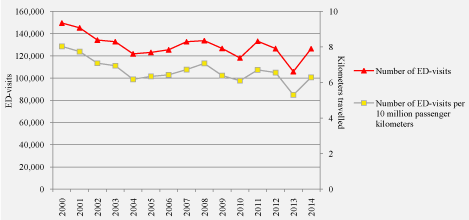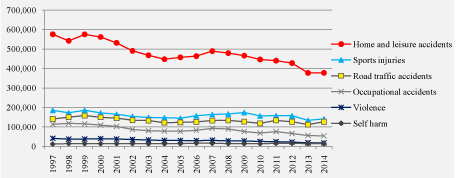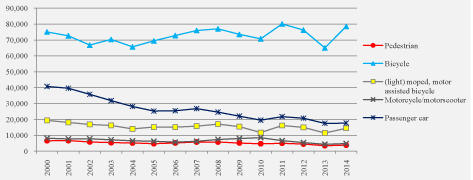
Research Article
Austin J Trauma Treat. 2017; 4(1): 1013.
Registration of Road Traffic Injuries at Emergency Departments in the Netherlands
Eilering MJ*, Klein Wolt K and Blatter BM
Department Monitoring and Registrations, Consumer Safety Institute (VeiligheidNL), Netherlands
*Corresponding author: Eilering MJ, Department Monitoring and Registrations, Consumer Safety Institute, Amsterdam, Netherlands
Received: October 18, 2016; Accepted: April 26, 2017; Published: May 08 , 2017
Abstract
In the Netherlands and also in other European countries there is a lack of police data on road traffic accidents [1,2]. The Dutch Injury Surveillance System (DISS) of the Consumer Safety Institute registers the number of injury-related Emergency Department-visits in the Netherlands due to different causes, such as occupational- and road traffic injuries. The goal of this study was to establish risk groups and risk factors for road traffic accidents. Data of DISS that were collected in 2014 were used for this purpose. Descriptive statistical analyses were performed on the injury data. Also, injuries were related to number of inhabitants and to passenger kilometers. In the Netherlands, in 2014, 126.000 victims of a road traffic accident visited the Emergency Department (ED) [3]. When looking at the absolute number of victims and cyclists, people between 65 and 74 year of age can be identified as target groups for prevention. With regard to the relative number of victims, when accidents were related to number of passenger kilometers, risk groups are children between 12 and 17 and people above 75 year of age [3,4].
Combined with data of the National road crash register in the Netherlands, the DISS data provides valuable information for creating and evaluating national and local interventions on traffic safety. When data on location of the accident are gathered as well, as was the case in a recent pilot study in the North of the Netherlands, the value of DISS even increases.
Keywords: Road traffic accident; Injury; Emergency department; Registration; Risk groups; Regional
Introduction
In the Netherlands, direct medical costs of road traffic accidents resulting in an ED-visit or hospital admission are high, comprising €400 million. This is 21% of the total direct medical costs in the Netherlands (€1,9 milliard) [3,5]. Understanding causes and risk groups provides important information for improving road safety and reducing high costs of health care. For several authorities, but especially at regional and local level, acquiring road traffic accident data is an important issue. It is known that the Registered Crashes database - containing the Dutch police data [6] - does not provide sufficient data. The Dutch Injury Surveillance System (DISS) of the Consumer Safety Institute registers the number of injury-related EDvisits in the Netherlands due to different causes, such as occupational –and road traffic injuries. The goal of this study was to establish risk groups and risk factors for road traffic accidents.
Methods
Dutch Injury Surveillance System Registration system
The Dutch Injury Surveillance System (DISS) registers data of individuals who visit Emergency Departments (EDs) of a selection of 13 hospitals in the Netherlands, injured due to an accident, an act of violence or self-harm. These hospitals form a representative sample of the general and university hospitals in the Netherlands providing a 24 hour accident and emergency service. This enables extrapolation of the recorded injury cases and of subsets of cases to national estimates. The quotient-estimate method is used, for extrapolation, given the auxiliary variable ‘number of ED-visits in the Netherlands [7].
Registration of road traffic injury data
In DISS a variety of variables is registered, for example demographic characteristics, referral to the ED and circumstances of the accident. In terms of road traffic injuries, the most important variables are ‘mechanism of transport accident’, ‘mode of transport victim’, ‘transport function victim’, ‘injury mechanism’ and ‘type of injury’. In addition to these variables DISS registers a description of accident circumstances and location, if present. In the participating hospitals ED staff registers the data for every injury patient in the Electronic Medical Record (EMR). To minimize the workload of the ED staff, existing data (e.g. gender, age, admission date and referral to the ED) of the EMR are used as much as possible. More specific variables like ‘means of transport’ require an additional registration of the ED staff in the EMR. The ‘injury mechanism’ (e.g. collision with an obstacle) and ‘type of injury’ (e.g. bone fracture) are filtered out from an open-text field by an automatic text processor. In order to obtain the best possible quality and completeness of data, the ED staff is instructed by the Consumer Safety Institute about encryption and how to fill in the open-text fields. In order to ensure the patients privacy an opt-out procedure is part of the data collection procedure.
The Consumer Safety Institute receives injury data from the ED monthly and data quality is monitored. When the data file is complete and extrapolation is applied, analyses are performed at national level.
Results
Number of road traffic accidents
In the Netherlands, in 2014 126.000 (n=13.928) victims of a road traffic accident visited the Emergency Department. In perspective of the national estimated passenger kilometers in the Netherlands, the overall risk for a road traffic accident with ED-visit was 6 per ten million passenger kilometers [3,4]. In absolute numbers, between 2000 and 2014 the number of ED-visits due to injury from a road traffic accident decreased (Figure 1). However, since 2004, the number of road traffic accidents has been quite stable. Even when the number of ED-visits is related to passenger kilometers, the results are the same. This is remarkable because all other causes of injury, such as home and leisure-, sport-related-or occupational accidents, are decreasing (Figure 2).

Figure 1: Trend road traffic accidents 2000-2014: Emergency Department visits (per 10 million passenger kilometers) in the Netherlands. Dutch Injury Surveillance
System 2000-2014, Consumer Safety Institute, Netherlands; Research Institute for Road Safety 2000-2014; Research Relocation in the Netherlands.

Figure 2: Trend road traffic accidents 2000-2014 by cause of injury: Emergency Department visits in the Netherlands. Dutch Injury Surveillance System 2000-2014,
Consumer Safety Institute, Netherlands.
In 2014, in both absolute and relative numbers, men (69.700, 55%) visited the ED more often than women (56.800, 45%). However, women were at greatest risk with 7 ED-visits per 10 million passenger kilometers compared to 6 ED-visits among men (Figure 3). In absolute numbers, people between 60 and 64 year of age most often got injured due to a road traffic accident and needed to visit the ED. Risk groups are however children between 12 and 17 and people above 75 year of age.

Figure 3: Road traffic accidents 2014 by age and gender: Emergency Department visits (per 10 million passenger kilometers) in the Netherlands. Dutch Injury
Surveillance System 2014, Consumer Safety Institute, Netherlands; Research Institute for Road Safety 2014; Research Relocation in the Netherlands.
In 2014, absolute numbers show that most road traffic accidents resulting in an ED-visit occurred among cyclists (Figure 4). 62% of all road traffic accidents were cyclists. Accidents with a passenger car (14%) and accidents with a (light) moped or motor-assisted bicycle (11%) followed. Despite the fact that most traffic accidents occurred among cyclists, they were not at greatest risk. When relating the number of ED-visits to passenger kilometers, (light) mopeds or motor-assisted bicycles are at greatest risk for an ED-visit due to injury from a road traffic accident with 118 ED-visits per 10 million passenger kilometers (Figure 5). Cyclists follow (48 ED-visits), where after motor cyclists are in third position (46 ED-visits).

Figure 4: Trend road traffic accidents 2000-2014 by type of traffic participant: Emergency Department visits in the Netherlands. Dutch Injury Surveillance System
2000-2014, Consumer Safety Institute, Netherlands.
Concerning types of traffic participants, in absolute numbers cyclists between 60-74 year of age most often got injured due to a traffic accident (Figure 6). With regard to the relative number of victims, when accidents were related to number of passenger kilometers, risk groups were (light) mopeds and motor assisted bicycles between 12 and 24 year of age and cyclists above 75 year of age.
In the past 15 years, the absolute number of ED-visits due to road traffic accidents with a bicycle increased. In contrast, ED-visits of other types of traffic participants decreased or showed fluctuations (Figure 4). When relating the number of ED-visits to passenger kilometers, the risk of a road traffic injury resulting in an ED-visit decreased for all types of traffic participants (Figure 5). Although the risks decreased in the past 15 years, both the absolute number of ED- visits and the ED-visits per 10 million passenger kilometers were high in 2014.

Figure 5: Trend road traffic accidents 2000-2014 by type of traffic participant: Emergency Department visits per 10 million passenger kilometers in the Netherlands.
Dutch Injury Surveillance System 2000-2014, Consumer Safety Institute, Netherlands; Research Institute for Road Safety 2000-2014; Research Relocation in the
Netherlands.
In 2014, most victims of a road traffic accident were injured at the shoulder, arm or hand (42.300, 33%), followed by injury of the hip, leg or foot (30.200, 24%) (Table 1). When type of injury was concerned, brain injuries were most common (10.300, 8%), distinguishing between mild brain injury (7.100, 6%) and severe head or brain injury (3.300, 3%).

Figure 6: Road traffic accidents 2014 by age and type of traffic participant: Emergency Department visits (per 10 million kilometers travelled) in the Netherlands.
Dutch Injury Surveillance System 2014, Consumer Safety Institute, Netherlands, Research Institute for Road Safety 2014, Research Relocation in the Netherlands.
Injury location
Number
%
Most common type of injuries
Number
%
Head/neck
25.600
20
Brain injury
10.300
8
Torso/spine
13.900
11
Mild brain injury
7.100
6
Shoulder/arm/hand
42.300
33
Serious skull/brain injury
3.300
3
Hip/leg/foot
30.200
24
Fracture clavicle/shoulder
6.700
5
Other
14.500
11
Superficial injury/contusion head
6.500
5
Fracture wrist
6.500
5
Total
126.000
100
Fracture hand/finger
6.100
5
Table 1: Road traffic accidents 2014 by injury location and most common type of injuries: Emergency Department visits in the Netherlands. Dutch Injury Surveillance System 2014, Consumer Safety Institute, Netherlands.
Discussion
Strengths of this study were the large number of Emergency Departments that were included in the sample (13) and related to this, the large sample of injuries that was monitored. In the DISS, between 75.000 and 80.000 injuries are monitored every year. As a result, numbers are large enough to report on the injury rates monthly or in separate regions. In 2015 and 2016, the Consumer Safety Institute performed a pilot study in the North of the Netherlands to explore the value of DISS-data in the surveillance of road traffic accidents, focusing on accident location [8]. The ED of the participating hospital registered all road traffic injuries specially focusing on accident location. Causes of accidents were for instance loose paving stones, damaged or slippery roads or a dangerous intersection, circumstances that authorities can take actions upon to increase road safety. After the pilot study was conducted, results were compared with the currently used National road crash register in the Netherlands concerning the number of registered road traffic accidents. Approximately 85% more victims with a hospital admission due to a road traffic accident were detected by DISS-data compared to the National road crash register in the Netherlands. Especially one-sided bicycle accidents were hardly reported in the National road crash register in the Netherlands. Combined with these data, the DISS data provides valuable information for creating and evaluating national and local interventions on traffic safety. When data of accident location are gathered as well, as was the case in a recent pilot study in the North of the Netherlands, the value of DISS even increases.
Our study has some weaknesses as well. For instance, to establish relative risks or rates, external denominator data are needed, because they are not available at the ED. Since DISS is a representative sample and data are extrapolated to the total Dutch population based on this assumption, national denominator data are used to calculate relative risks and risk groups, such as general demographic data and data on traffic movements gathered by the Research Institute for Road Safety. In the latter, that is performed yearly, the passenger kilometers per means of transportation are reported. Denominator data are not calculated by means of hospital catchment areas because these are too difficult to establish.
In addition, although general information on the circumstances of the injury are gathered by administrative personnel or nurses at the EDs, the emergency situation does not enable to gather detailed causes and circumstances such as if a smart phone was used while driving, if the road was not illuminated enough or which type of bicycle was used. In depth research by means of questionnaires sent to ED patients is needed to answer research questions on the relation with these kind of factors.
Conclusion
In this study, we found that despite the decreasing number of injuries due to road traffic accidents resulting in ED-visits in the last 15 years, road traffic injuries have decreased less than other injuries. Results from analyses of 2014 data show that important risk groups concerning age are children between 12 and 17 year and people above 75 year of age. Regarding means of transportation, driving (light) mopeds and motor-assisted bicycles cause the largest injury risks. More specifically, (light) mopeds and motor assisted bicycles between 12 and 24 year of age and cyclists above 75 year of age are at greatest risk. Further research among these risk groups is needed to gain more insight into the severity, specific causes and specific locations of the accidents. The pilot study in the North of the Netherlands showed that data of accident locations are very useful for policy making at regional level. The DISS of the Consumer Safety Institute is a highly suitable data source for this purpose.
References
- RADaR - Road Accident Data Recorder application.
- Derriks HM, Mak PM. Underreporting of road traffic casualties. Ministry of Transport, Public Works and Water management. 2007.
- Dutch Injury Surveillance System. Consumer Safety Institute. 2000-2014.
- Research Institute for Road Safety. Research Relocation in the Netherlands. 2000-2014.
- Eilering MJ, Stam C (2014). Road traffic accidents 2014. Consumer Safety Institute.
- National road crash register Netherlands. Centre for Transport and Navigation. Ministry of Infrastructure and Environment.
- Gaakeer MI. Inventory of Emergency Department-visits and self-referrals. Netherlands Journal of Medicine, 2014, 158: A7 128.
- Eilering MJ, Toet H, Meulen S van der. Final report pilot traffic Friesland. Consumer Safety Institute. 2016.